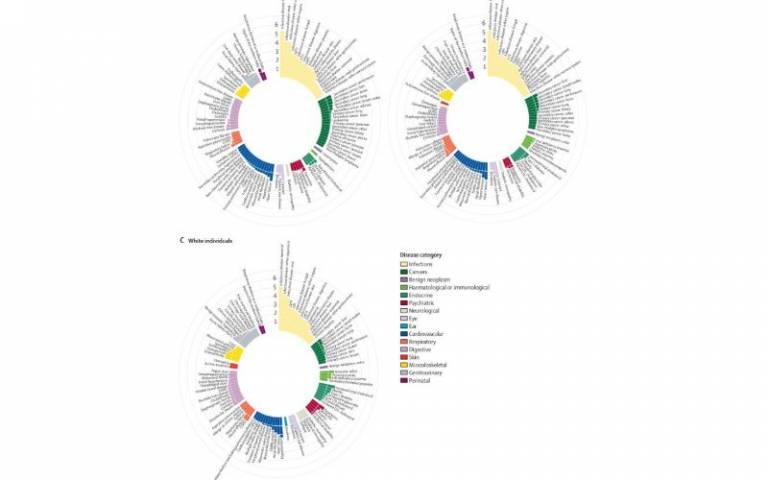New paper: Identifying and visualising multimorbidity and comorbidity patterns in NHS patients
30 November 2022
Dr Valerie Kuan and the Multimorbidity Mechanism and Therapeutic Research Collaborative (MMTRC) publish on multimorbidity and comorbidity patterns in Lancet Digital Health.

Globally, there is a paucity of multimorbidity and comorbidity data, especially for minority ethnic groups and younger people. We estimated the frequency of common disease combinations and identified non-random disease associations for all ages in a multi-ethnic population.
In this population-based study, we examined multimorbidity and comorbidity patterns stratified by ethnicity or race, sex, and age for 308 health conditions using electronic health records from individuals included on the Clinical Practice Research Datalink linked with the Hospital Episode Statistics admitted patient care dataset in England.
We collected data for almost four million eligible patients and found that a higher proportion of boys aged 1–9 years had two or more diagnosed conditions than did girls in the same age group, but more women and girls were diagnosed with multimorbidity than were boys aged 10 years and older and men. White individuals were more likely to be diagnosed with two or more conditions than were Black or south Asian individuals.
Among many other co-occurrences, we found depression commonly co-occurred with anxiety, migraine, obesity, atopic conditions, deafness, soft-tissue disorders, and gastrointestinal disorders across all subgroups. Heart failure often co-occurred with hypertension, atrial fibrillation, osteoarthritis, stable angina, myocardial infarction, chronic kidney disease, type 2 diabetes, and chronic obstructive pulmonary disease.
Our findings and interactive online tools are a resource for: patients and their clinicians, to prevent and detect comorbid conditions; research funders and policy makers, to redesign service provision, training priorities, and guideline development; and biomedical researchers and manufacturers of medicines, to provide leads for research into common or sequential pathways of disease and inform the design of clinical trials.
We are funded by UK Research and Innovation, Medical Research Council, National Institute for Health and Care Research, Department of Health and Social Care, Wellcome Trust, British Heart Foundation, and The Alan Turing Institute.
 Close
Close

